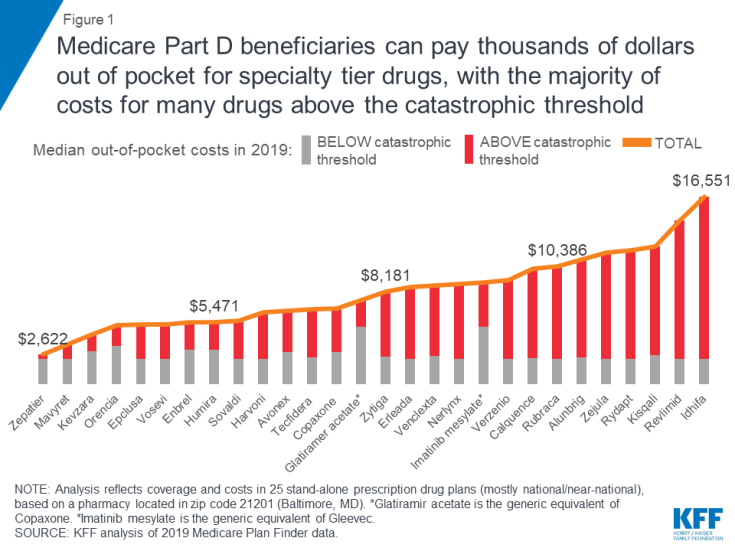The Out-of-Pocket Cost Burden for Specialty Drugs in Medicare Part D in 2019
Medicare Part D has helped to make prescription drugs more affordable for people with Medicare, yet many beneficiaries continue to face high out-of-pocket costs for their medications. Specialty tier drugs—defined by Medicare as drugs that cost more than $670 per month in 2019—are a particular concern for Part D enrollees in this context. Part D plans are allowed to charge between 25 percent and 33 percent coinsurance for specialty tier drugs before enrollees reach the coverage gap, where they pay 25 percent for all brands, followed by 5 percent coinsurance when total out-of-pocket spending exceeds an annual threshold ($5,100 in 2019). While specialty tier drugs are taken by a relatively small share of enrollees, spending on these drugs has increased over time and now accounts for over 20 percent of total Part D spending, up from about 6 to 7 percent before 2010.
This analysis draws on data from Medicare’s Plan Finder website to calculate expected annual 2019 out-of-pocket costs for 30 specialty tier drugs used to treat four health conditions—cancer, hepatitis C, multiple sclerosis, and rheumatoid arthritis. For each drug, we calculate the median annual out-of-pocket cost across all plans that cover the drug, based on coverage in stand-alone prescription drug plans (PDPs) and costs at a pharmacy in zip code 21201 (Baltimore, MD). We use one zip code to represent PDP costs nationally because most PDPs are offered on a national or near-national basis (including 24 of the 25 PDPs in the 21201 zip code), and it is common for PDPs to use the same formulary and the same specialty tier coinsurance rate in all regions. As such, our findings are broadly applicable to a majority of PDP enrollees nationwide. (See Methods for additional details.)
Key Findings
- Medicare Part D enrollees not receiving low-income subsidies can expect to pay thousands of dollars out of pocket for a single specialty tier drug in 2019 (Figure 1). Median annual out-of-pocket costs in 2019 for 28 of the 30 studied specialty tier drugs range from $2,622 for Zepatier (for hepatitis C) to $16,551 for Idhifa (for leukemia), based on a full year of use; two of the 30 drugs are not covered by any plan in our analysis in 2019.
- Part D enrollees taking high-cost specialty tier drugs can incur significant costs in the catastrophic phase. For the 28 studied specialty tier drugs covered by some or all plans in our analysis, the share of out-of-pocket costs that an enrollee would incur in the catastrophic phase in 2019 ranges from 13 percent for Zepatier to 86 percent for Idhifa, based on a full year of utilization. More than half (61 percent) of expected annual out-of-pocket costs for these 28 drugs in 2019 would occur in the catastrophic phase, on average, which translates to $5,444 in out-of-pocket costs in the catastrophic phase alone.
- Not all specialty tier drugs are covered by all Medicare Part D plans, unless they are in one of the six protected classes (such as cancer drugs). For the 14 specialty drugs in our analysis that are not covered by some or all plans in 2019, the median total annual cost when not covered ranges from $26,209 for Zepatier to $145,769 for Gleevec—amounts that far exceed the limits of affordability for the vast majority of Medicare beneficiaries.
- In 2019, annual out-of-pocket costs are 12 percent higher than in 2016, on average, for 8 of the 10 specialty tier drugs analyzed in both 2016 and 2019 and covered by plans in both years. For these specialty tier drugs, median annual out-of-pocket cost increases range from $224 for Copaxone, a multiple sclerosis drug, to $2,923 for Revlimid, a cancer drug. For two of the 10 drugs—Harvoni and Sovaldi, both used to treat hepatitis C—annual out-of-pocket costs are somewhat lower in 2019 than in 2016, possibly due to the entrance of competitor products since the end of 2015 and other factors related to changes in the benefit design and the limited duration of treatment that translate to a reduction in out-of-pocket costs for these drugs.
- With the now-complete closure of the Part D coverage gap for brand-name drugs, enrollees can expect to face lower annual out-of-pocket costs for selected specialty tier drugs below the catastrophic threshold in 2019 compared to 2016, but higher costs above—driven by an increase in underlying total costs between 2016 and 2019. For example, for Humira, for rheumatoid arthritis, median out-of-pocket costs below the catastrophic threshold decreased by $99 between 2016 and 2019 (from $3,155 to $3,057), while costs above the catastrophic threshold increased by $705 over these years (from $1,709 to $2,414)—and in total, expected annual out-of-pocket costs for Humira are $606 (12%) higher in 2019 than in 2016.

